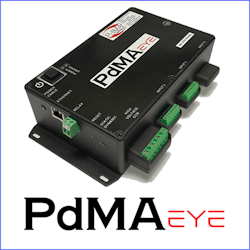Vice President – Product Development
PdMA® Corporation
In the case of motors, the lifespan can be optimized. Optimal motor management and maintenance improves reliability, ensures the best return on asset values, decreases downtime, and effectively establishes more cost-effective manufacturing.
To learn more about the perks of PdM, Chemical Processing sat down with Noah Bethel, vice president of product development at Tampa-based PdMA® Corporation, a provider of electric motor testing instruments and predictive maintenance and condition monitoring solutions.
Q: What are some of the main benefits of permanently installed solutions?
A: The number one thing is reliability. Permanently installed technology is being monitored 24 hours a day; you are optimizing the early indication of faults so that you can get ahead of them, minimize the damage to the system, reduce the time to production in the event of an outage.
Number two is safety. With energized gear, there are rules and regulations to follow to keep you safe. When you permanently install a solution, it allows you to look at the same data you used to collect in the vicinity of energized gear from the safety of your desktop. That's hard to argue with.
The third is data reliability. Humans make mistakes. The more variables you can remove, the less likely you'll have human error involved. By installing technology, you have to go through an installation and launch, so you're overcoming all the errors that someone might make on a test-by-test situation when they're connecting the equipment to an asset.
Q: What about the challenges?
A: Challenges are always present but not in terms of installation — that's all pretty straightforward and quite simple. The challenges come from acceptance of the industry.
A decade ago Wi-Fi was unacceptable. People thought it was unreliable and unsecure but it's almost everywhere now. Cloud technology experienced early innovative resistance, too, but it’s getting a lot more acceptance.
You have to do your due diligence and make sure that you've got all the security in place to remove people's fears and concerns.
Another challenge is nuisance alarms. A lot of people installing permanent technology don't spend the time to ensure that the machine is learning and reassessing the alarm set points, and as a result, there are nuisance alarms. People stop paying attention.
Q: Do operators take permanently installed solutions for granted; the set-it-and-forget-it mindset?
A: They absolutely do. In a past article we referenced a case study looking at data, alarms and understanding them. A utility plant had a situation where they weren’t looking into an alarm. They said, "Oh, it alarms all the time. It's just a nuisance alarm."
The problem was that their nuisance alarm had grown. That one element was an alarm, which happened to be a phase imbalance. But the phase imbalance eventually correlated with a second dismissed alarm showing high temperature on two phases.
Q: What impact has COVID-19 had on the movement toward permanently installed solutions?
A: COVID basically locked people out of the workplace so we got an influx of requests to get permanently installed technology to provide access to technicians who used to go out and feel and touch and listen to the motors. Now they can do that from their office at home so it has had a significant impact on the increase in demand.
Figure 1. PdMA® Corporation helps its customers accomplish goals by monitoring the health and condition of electric motors with its advanced electric motor testing technologies.
Q: Are there any other influences that lead to permanently installed solutions?
A: Baby boomers retiring. There were an average 2 million-per-year retirees leading up to 2019. In 2020, there was 3.2 million. So, you've got younger workers who aren't quite adept, but you also have people who are retired and willing to work from their back porch in places like sunny Tampa, Florida. Having access to these experts who just need a computer and a secure internet connection to help the on-site guy look at the data is priceless.
Another issue — college kids aren’t rushing to get into the maintenance industry. As a result, companies are looking for ways of getting data to third-party personnel, even local service shops, who have some expertise. So permanently installed technology is another answer for that situation.
Q: Are portable solutions still relevant?
A: Without question and for a variety of reasons. Number one, not every asset is going to qualify for 24-hour critical monitoring. That's just a financial decision. Portable solutions enable testing on an annual or semi-annual basis.
The other thing is there is a lot of portable technology that tests motors when they're offline. Specifically, one of our big fault zones, which is the insulation fault zone, is better left to de-energized or portable technology.
Another reason is troubleshooting. There may not be a problem with the motor — it could be operator error. You have this great permanently installed technology waiting to tell you what's going on but there was something unrelated to a maintenance anomaly that caused the motor to turn off. That’s where offline portable technology comes in.
Also, there is the case for storage and warehousing situations — when motors are sitting on a shelf and de-energized. So, again, from a motor perspective, there's a lot of places that permanently installed just can't help you out.
Q: How do you decide which approach is best?
A: Criticality is the number one issue. That involves impact on production, impact on the environment, and the impact on cost. Then you consider replaceability. Sometimes motors aren't that expensive but to get a replacement or to get it repaired is going to take so long that it will become critical. Those are the four areas under the criticality that I think most people put into the decision of, "Okay, this is going to qualify for permanently installed."
The other big area besides criticality, in our assessment, is resource availability. Because no matter what, if you do not have the resources to go out and even test the critical stuff, or even the subcritical stuff, you're in trouble in terms of maintenance and reliability. If you have resource-availability issues, you’ll have to permanently install a certain number of assets and offshoot the analysis to the local service company.
Q: How do you maintain these maintenance tools?
A: One advantage to permanently installed is that it gets installed and it stays there. It doesn't bounce around in the back of a pickup truck, it doesn't fall down the stairs, it doesn't get dropped into the puddle. Additionally, re-calibration of our permanently installed technology isn’t required. That doesn't mean that there's not going to be facilities that, under ISO restrictions, must calibrate their equipment. So, we do have re-calibration services available.
Q: Anything you’d like to add?
A: We sell a lot of technology to motor repair shops. As a result of them being motor experts, they are heavily equipped with resources and personnel who know motors very well. As a product of the challenges we spoke of earlier (baby boomer/pandemic/younger generation not being interested), the service industry has identified this quite vertical business opportunity for themselves. They are recognizing that they can suggest permanently monitoring motors and in doing so they can extend the warranty an additional year or multiple years because now they're the ones paying attention. So, it’s a win-win. Our goal is to help our customers work more efficiently and effectively within an environment of shrinking resources — and this is an interesting way to do it.
For more on PdMA® Corporation, visit: www.pdma.com


